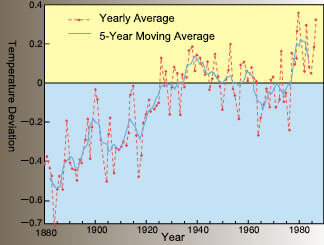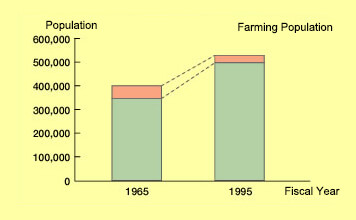

Farmers built up Niigata's tideland using their dobune (dredge-boats) over hundreds of years. Now, that land is sinking. The land has subsided more than one meter over wide areas. Some regions have subsided more than two meters.
What will happen if this artificial plain goes even lower? The tideland is still moving today.
Crisis impends not only from subsiding ground but from the sea as well. Global warming (see graph below) will likely melt ice in the Arctic and Antarctic, leading to higher sea levels. Snow accumulation in Niigata is markedly less than before. Who can say for sure that the area will not come back to what it looked like on the year-1089 map?

Annual Change in Average Global Ground Surface Temperature (Showing Deviation in Average Values from 1951 through 1980) [Hansen 1988]
While the population of Niigata City grew 40% in 30 years, there was a 57% decrease in the farmers' population. The operation and maintenance of agricultural facilities is becoming an endless heavy burden for farm households. Moreover, since irrigation canals have also traditionally provided water for the daily life of the residents, their management has always been done under the responsibility of each community since long ago. The number of non-farm households in the agricultural areas has increased due to recent conversions of paddy fields into housing and other purposes. As a result, the quality of water in irrigation canals has deteriorated due to contamination from domestic wastewater, and makes individual communities more difficult to maintain the water channels.
■Total Population and Farming Population of Niigata City

Many of the major pump stations which have drained the Niigata Plain almost reach the end of their service life of 20 years which is set in their business plans. As these facilities cannot be rehabilitated without stopping the pumps (in which case the surrounding areas will immediately be inundated), the region has to face crucial problems in terms of technology and cost.